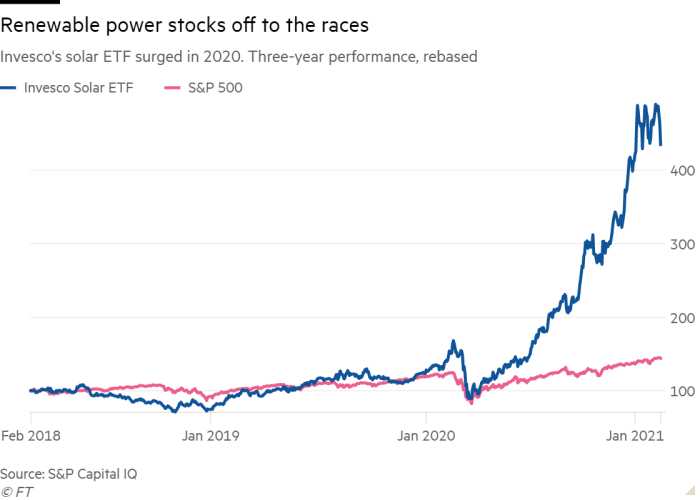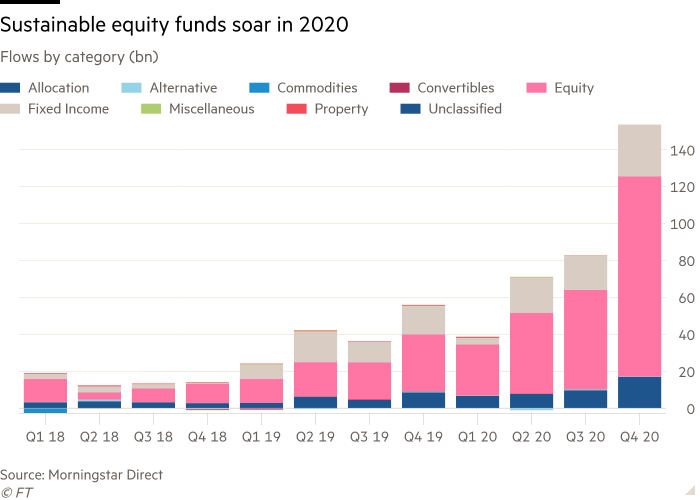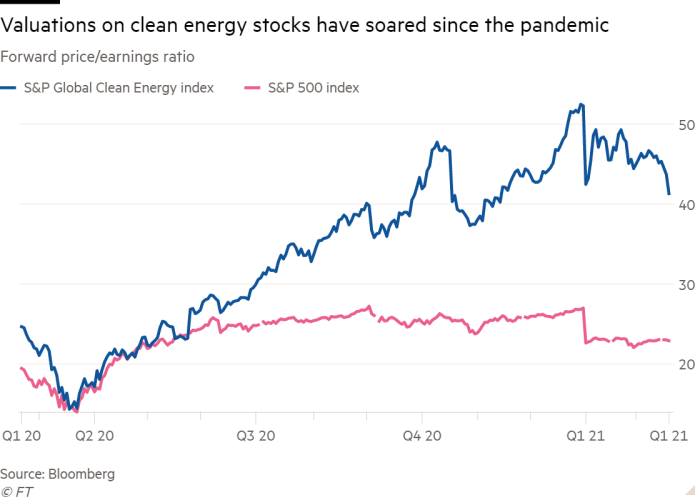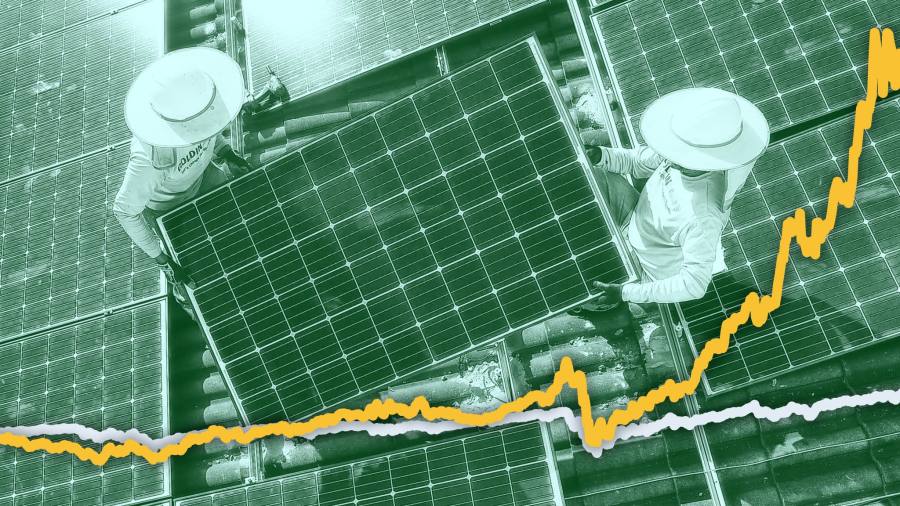[ad_1]
This article is part of the FT’s Runaway Markets series
As the enthusiasm for climate-friendly investing hits fever pitch, analysts warn that investors are pumping cash into anything that looks “green†— sending valuations of eco-friendly companies into the stratosphere and fanning fears of a bubble.
Larry Fink, chief executive of the world’s biggest asset manager, BlackRock, said last month that the market is undergoing a “tectonic shift†towards sustainable investments. Global funds linked to environmental, social and governance principles took in nearly $350bn last year, compared with $165bn in 2019, according to data from Morningstar.
The green portion of that investment has been encouraged by a massive change in consumer demand. BloombergNEF data show that companies, governments and households spent more than $500bn on renewable energy and electric vehicles in 2020.Â
With countries committing to cut their greenhouse gas emissions, ESG enthusiasts expect green investments to shoot even higher. But some executives and analysts think sustainability-linked stocks are starting to get overheated. This week, oil group Total’s chief executive warned of “crazy†valuations in the renewable sector, in an interview with the Financial Times.
“I think we’re 100 per cent in a green bubble,†said Gordon Johnson, chief executive of GLJ Research. “Pretty much every solar company I cover, their numbers got worse and the stock, like, tripled . . . This is not normal.â€

The S&P Global Clean Energy index, which tracks the share price of 30 companies, has almost doubled in value in the past year, giving it a valuation of 41 times its companies’ expected profits, according to Bloomberg data. By contrast, US blue-chip stocks are up about 16 per cent in the past year, and are valued at 23 times forward earnings.
A recent paper by Morgan Stanley found that a basket of “green†stocks saw their PE multiples increase by an average of 24 points over 2020, compared with two points for sector peers.
One example of a dizzying single-stock rally is US-based solar provider SunPower, which saw its share price skyrocket in late 2020 and early 2021, before giving up some gains in February.
Retail investors have piled in to the stock, said Moses Sutton, analyst at Barclays, because it is a well-known brand linked to the energy transition. They have gone up against hedge funds betting that SunPower will struggle to gain market share against larger operators in the solar panel market such as Sunrun and Tesla. “Who’s going to win that battle is a great question,†said Sutton.
Danish power company Orsted, one of the leading players in the offshore wind market, has also soared. It is one of a few large energy companies that clears the bar for strict climate-conscious investors. It has seen its stock price almost triple in three years, despite only modest earnings growth.

“There was a period about seven or eight years ago when every fund had Apple,†said Mark Freshney, analyst at Credit Suisse. “And it’s a little bit like that in utilities with Orsted.â€
Orsted said it continued to expect “value-creating investment opportunitiesâ€, citing US state mandates to build offshore windfarms.
Such stocks have been supported by a flood of money into sustainable funds. Equity funds accounted for more than $230bn of inflows into this segment last year, according to Morningstar. A flurry of green Spacs have also hit the market in search of acquisition targets.Â
“Initially we saw a lot of interest around a limited number of [ESG] names that performed pretty well,†said Colin Rusch, analyst at Oppenheimer. “But in the second half of 2019 into last year, we have seen an extremely broad base of investors starting looking across all of the companies leveraged to mitigating climate change.â€
Policymakers fed the demand, with Joe Biden pledging to invest trillions in decarbonising the US economy and his Chinese counterpart, Xi Jinping, pledging the country will be carbon neutral by 2060.

Sector bulls are unlikely to be deterred by near-term valuations, analysts said. Investors buying into wind companies are not simply valuing their existing assets and those under construction, Credit Suisse’s Freshney said. They are taking the view that Orsted and other leaders in the field will be able to capitalise on the move away from fossil fuels over the next 30 years.
However he warns they may be overlooking substantial risks, such as offshore wind projects being derailed over environmental concerns and the threat of bigger energy companies buying up available seabed rights.
A similar story is playing out in the hydrogen sector where Plug Power, a hydrogen fuel company, has seen its share price rise almost 50 per cent since the beginning of 2021, taking its market value to $25bn.
Runaway Markets

In a series of articles, the FT examines the exuberant start to 2021 across global financial markets. Here is a selection:
Sutton at Barclays thinks Plug Power’s market capitalisation — about 80 times Capital IQ’s estimate for its 2021 revenue — has outrun its intrinsic value, even looking at the most optimistic future scenarios for the hydrogen fuel sector. He compares Plug Power’s position today with Microsoft’s position in 1999: even though Microsoft remained a leader in the tech sector following the dotcom crash, it took more than a decade for its shares to recover.
But the stock’s bulls bet that if the world does shift towards hydrogen fuel for core economic activities such as shipping, big gains are to be had.
“[Plug] has the opportunity to be a very large company on the order of $100bn-plus in market cap.†said Oppenheimer’s Rusch. “And so that’s what people don’t want to miss. They don’t want to miss Tesla again.â€
[ad_2]
Source link





